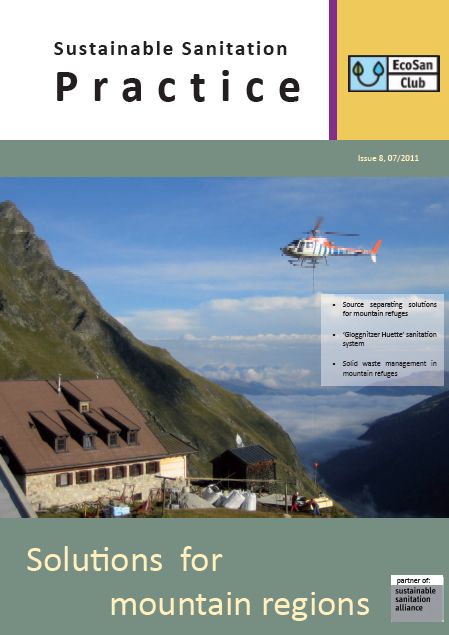
Published in: 2011
Publisher:
Sustainable Sanitation Practice (SSP), Issue 8. EcoSan Club, Austria
Author:
Ecosan Club (ed.)
Uploaded by:
SuSanA secretariat
Partner profile:
common upload
5606 Views
110 Downloads
Location of library entry
There are thousands of public and private mountain refuges located in the alpine regions. The increased number of visitors has raised the concerns on the environmental impact on the sensitive ecosystems.
To ensure sustainability, integrated management of the alpine infrastructure is needed. Water supply, energy, wastewater treatment and solid waste management need to be assessed together for planning the infrastructure in refuges. A main criterion for ensuring reliable and efficient operation of the refuge‘s infrastructure is the training and involvement as well as the engagement of the operator.
Issue 8 of Sustainable Sanitation Practice (SSP) on „Solutions in mountain regions“ shows some examples of solutions for mountain regions:
The first paper gives a short overview on 3 examples showing source separating sanitation solutions for refuges. Unfortunately we were not able to get full papers from these examples. Nevertheless we think that these interesting examples should be included.
Langergraber, G., Muellegger, E.
In this paper we introduce 3 examples of solutions for mountain refuges that are based on source separation and treatment of separated waste streams. Separation of wastewater streams (e.g. dry toilets) lowers the
pressure on water supply and reduces the environmental impact of a refuge (Weissenbacher et al., 2008). The aim of the paper is not to give a full description of the examples but to provide the interested reader with basic information. As it can be seen from the examples reuse is not the reason to implement source separating systems. However, the reduction of transport costs was the main driver for all refuges.
++++++++
The second paper describes the sanitation system for the ‘Gloggnitzer Huette’, a small mountain refuge located in a sensitive drinking water catchment.
Freiberger, E., Weissenbacher, N.
The sanitation system of a small mountain refuge situated in a sensitive drinking water catchment had to be adapted to reach appropriate wastewater treatment and disposal. As the refuge is dependent on hand-carried drinking water and photovoltaic energy supplies the energy and water demand of a new system had to be as low as possible. A combination
of a composting toilet, waterless urinals and a constructed wetland was foreseen to meet these requirements. Since the mountain refuge is opened at weekends only, peak loads have to be expected. A buffer tank was installed for flow equalisation and greywater storage during winter. With the help of a volume-controlled inflow pump, the greywater inflow can be distributed over a whole week preventing dry-out of the constructed wetland. The effluent of the constructed wetland is discharged in an evaporation bed. To increase the degradation of organic solids in the composting toilet, a solar heat collector is used for ventilation of the composting chamber. The system start up was in spring 2011. It will be
intensively monitored and shall serve as pilot for other mountain refuges under comparable conditions.
++++++++
The third and final contribution summarises the findings of a project on integral evaluation of supply and disposal
systems in mountain refuges in relation to solid waste management.
Lebersorger, S.
Waste management in mountain refuges is characterised by the decentralized position of mountain refuges, difficult transport conditions and the necessity to transport all waste generated to waste collection facilities in the valley. Based upon results from 100 Alpine mountain refuges, this paper describes the current status of solid waste management and provides recommendations, which can be used for other decentralized systems as well. The minimization of waste quantities is a key factor for reducing transport costs, and can be achieved by waste prevention, i.e. measures taken before something becomes waste, as well as by on site composting of biowaste. Attention should be paid to the compliance with legal requirements and the prevention of negative environmental impacts. The results of the project reveal that there is
need for information among operators of mountain refuges, in particular with regard to separate collection of hazardous waste, state-of-the-art composting and the illegality of burning wastes
Bibliographic information
Ecosan Club (ed.) (2011). Solutions for mountain regions. Sustainable Sanitation Practice (SSP), Issue 8. EcoSan Club, Austria
Filter tags
English Europe & Central Asia Practitioners Rural














